The Bhopal Gas Tragedy: An International Law Perspective and Analysis
VerifiedAdded on 2023/04/10
|8
|1299
|325
Report
AI Summary
The report provides an in-depth analysis of the Bhopal gas tragedy, the world's worst industrial disaster. It begins with an introduction, followed by an examination of the disaster's nature, including the leak of methyl isocyanate (MIC) gas from the Union Carbide India Limited (UCIL) pesticide plant and its devastating consequences. The report then explores the various litigations that followed, including lawsuits filed in the US and India, as well as the legal issues that arose, particularly the principle of absolute liability. The report also discusses whether justice was served, evaluating criminal proceedings and the failure to extradite Warren Anderson. The conclusion emphasizes the need for effective regulations to prevent future industrial disasters and the importance of stricter laws to ensure corporate accountability.
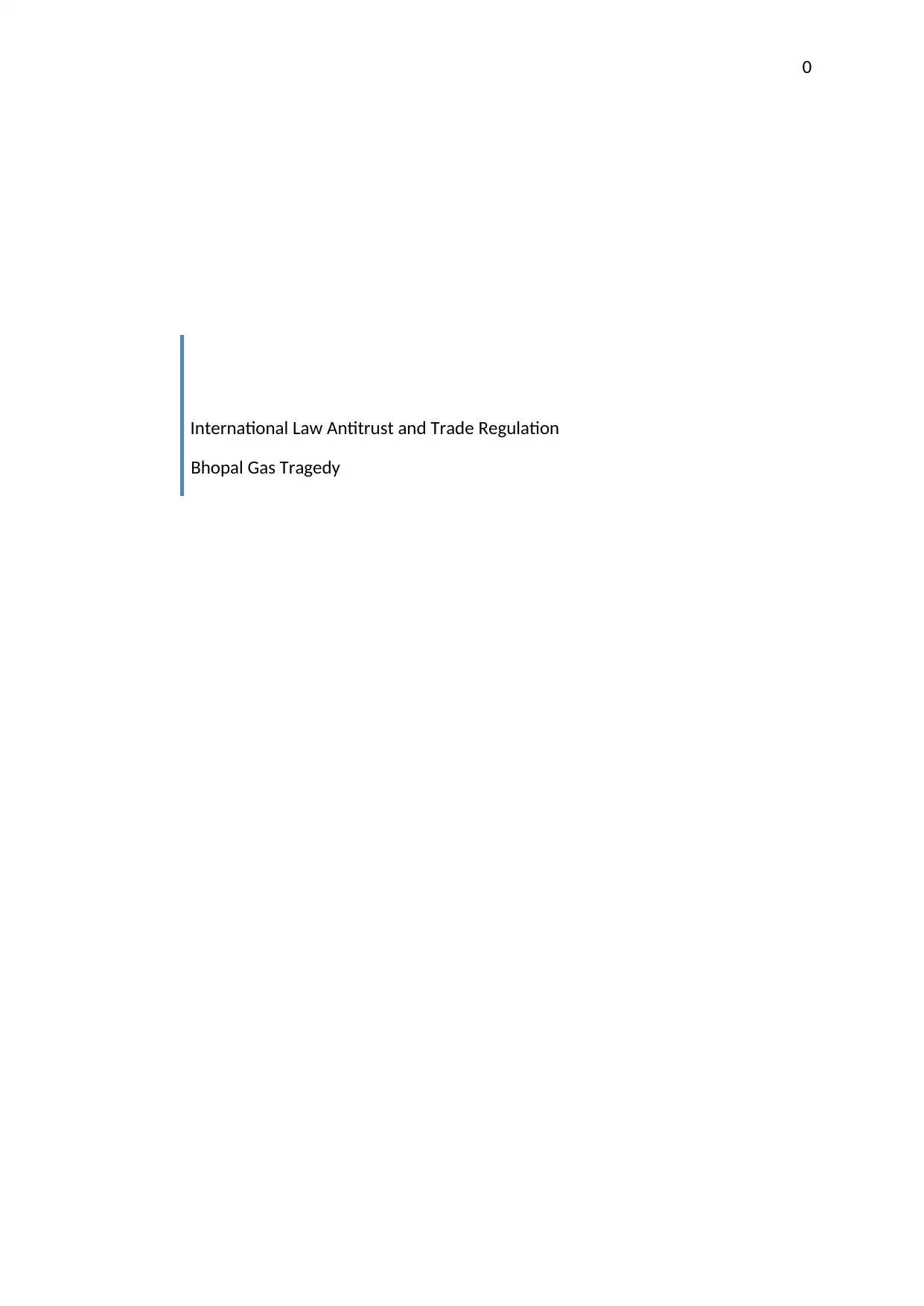
0
International Law Antitrust and Trade Regulation
Bhopal Gas Tragedy
International Law Antitrust and Trade Regulation
Bhopal Gas Tragedy
Paraphrase This Document
Need a fresh take? Get an instant paraphrase of this document with our AI Paraphraser
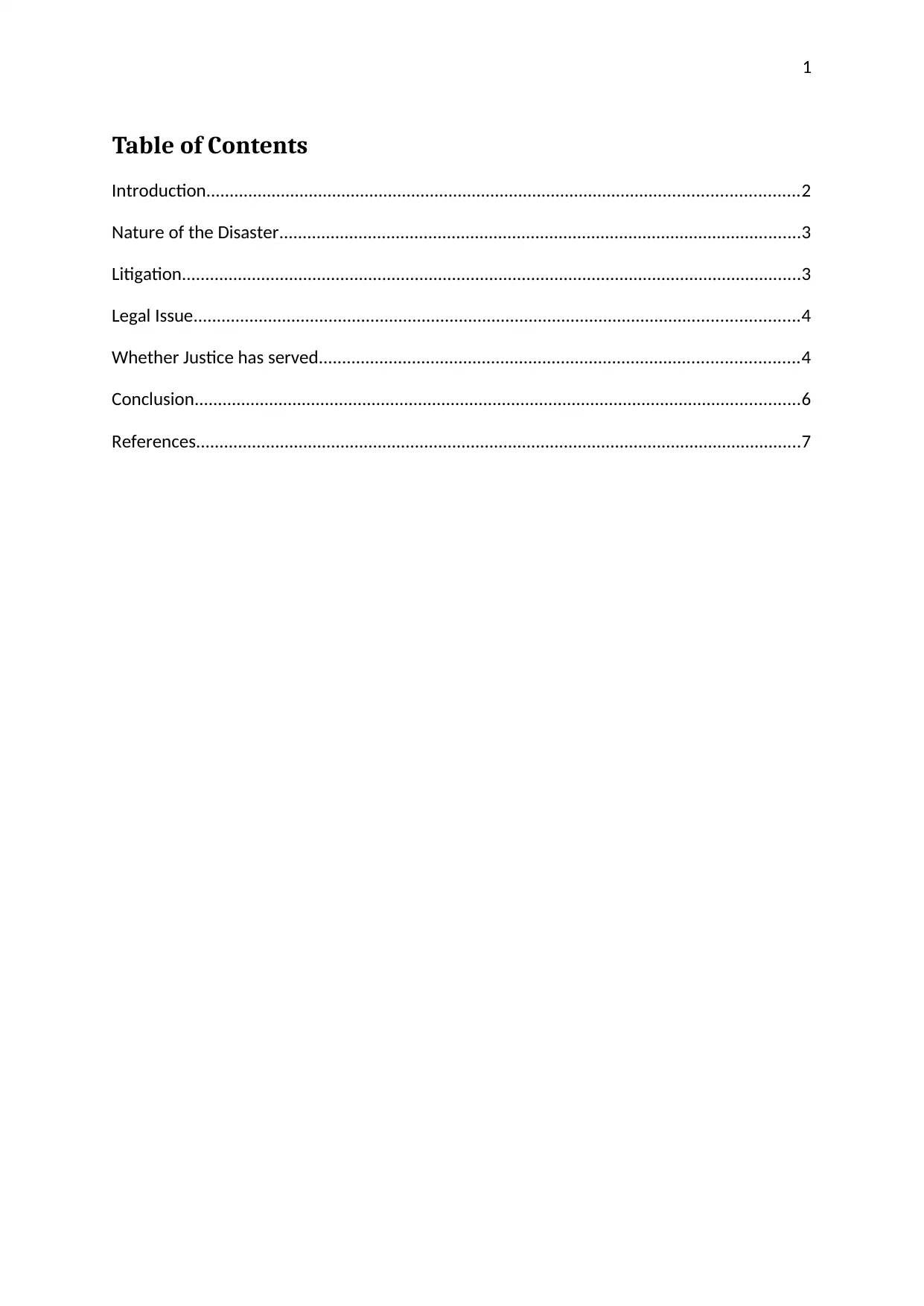
1
Table of Contents
Introduction...............................................................................................................................2
Nature of the Disaster................................................................................................................3
Litigation.....................................................................................................................................3
Legal Issue..................................................................................................................................4
Whether Justice has served.......................................................................................................4
Conclusion..................................................................................................................................6
References..................................................................................................................................7
Table of Contents
Introduction...............................................................................................................................2
Nature of the Disaster................................................................................................................3
Litigation.....................................................................................................................................3
Legal Issue..................................................................................................................................4
Whether Justice has served.......................................................................................................4
Conclusion..................................................................................................................................6
References..................................................................................................................................7
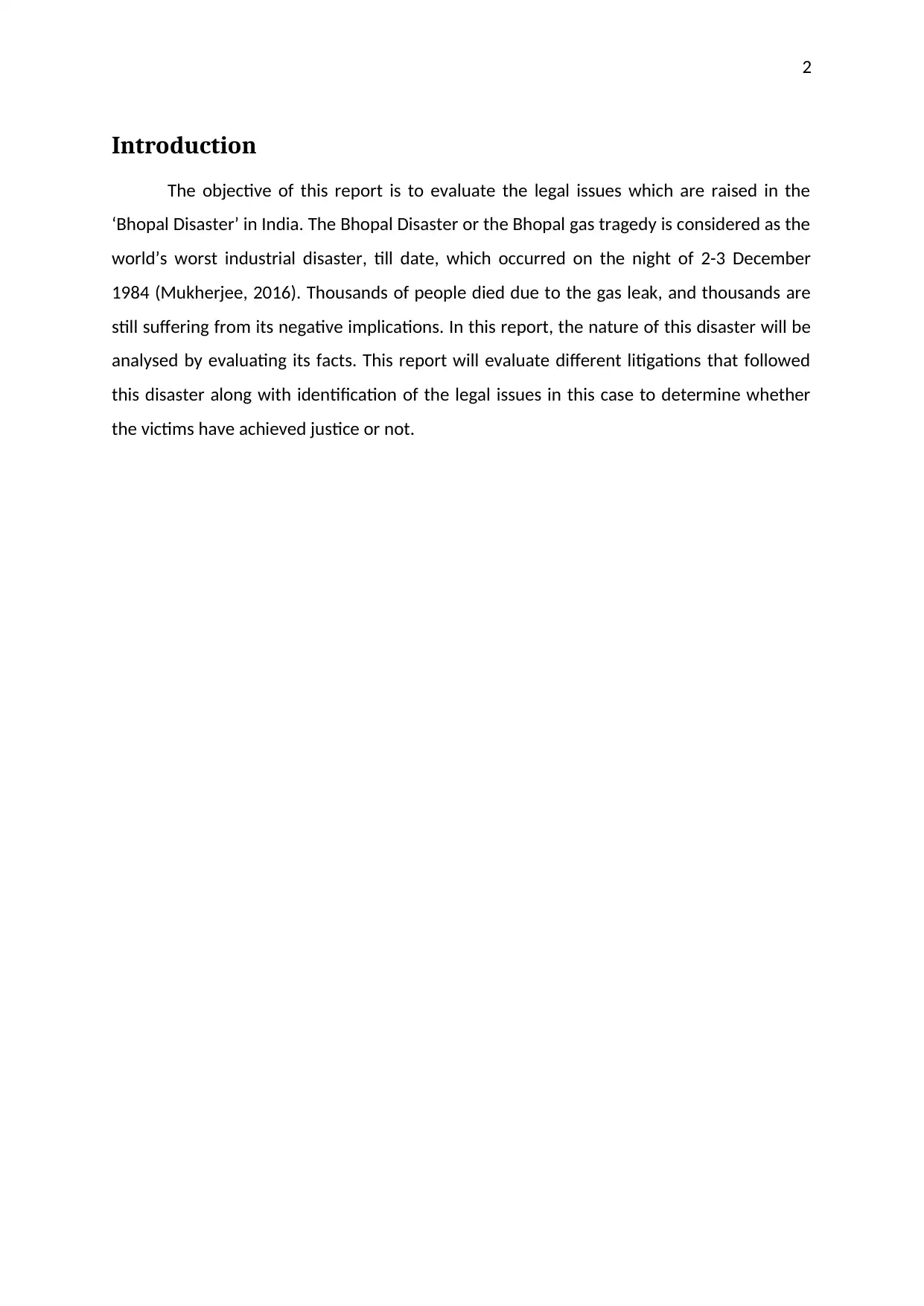
2
Introduction
The objective of this report is to evaluate the legal issues which are raised in the
‘Bhopal Disaster’ in India. The Bhopal Disaster or the Bhopal gas tragedy is considered as the
world’s worst industrial disaster, till date, which occurred on the night of 2-3 December
1984 (Mukherjee, 2016). Thousands of people died due to the gas leak, and thousands are
still suffering from its negative implications. In this report, the nature of this disaster will be
analysed by evaluating its facts. This report will evaluate different litigations that followed
this disaster along with identification of the legal issues in this case to determine whether
the victims have achieved justice or not.
Introduction
The objective of this report is to evaluate the legal issues which are raised in the
‘Bhopal Disaster’ in India. The Bhopal Disaster or the Bhopal gas tragedy is considered as the
world’s worst industrial disaster, till date, which occurred on the night of 2-3 December
1984 (Mukherjee, 2016). Thousands of people died due to the gas leak, and thousands are
still suffering from its negative implications. In this report, the nature of this disaster will be
analysed by evaluating its facts. This report will evaluate different litigations that followed
this disaster along with identification of the legal issues in this case to determine whether
the victims have achieved justice or not.
⊘ This is a preview!⊘
Do you want full access?
Subscribe today to unlock all pages.

Trusted by 1+ million students worldwide
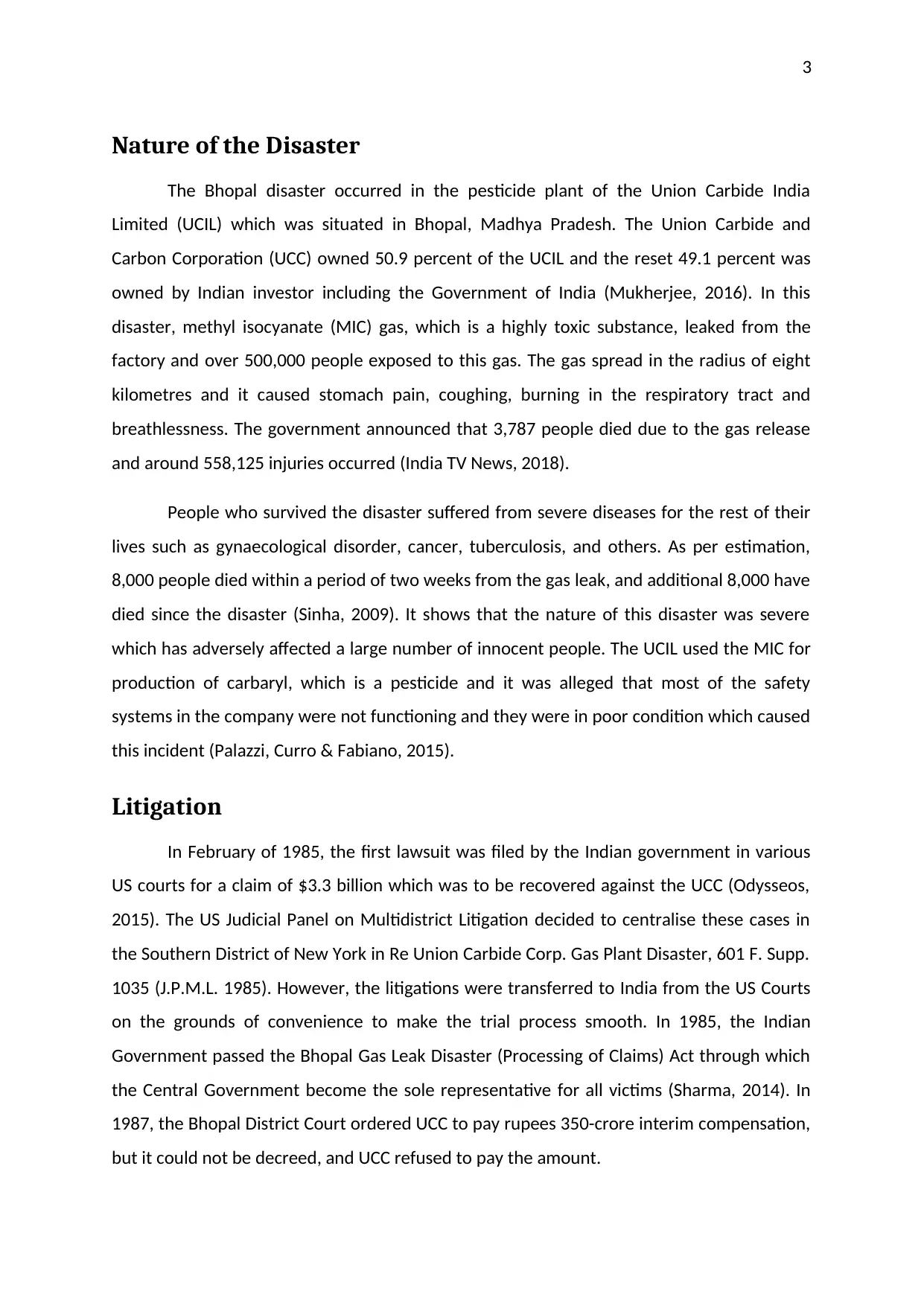
3
Nature of the Disaster
The Bhopal disaster occurred in the pesticide plant of the Union Carbide India
Limited (UCIL) which was situated in Bhopal, Madhya Pradesh. The Union Carbide and
Carbon Corporation (UCC) owned 50.9 percent of the UCIL and the reset 49.1 percent was
owned by Indian investor including the Government of India (Mukherjee, 2016). In this
disaster, methyl isocyanate (MIC) gas, which is a highly toxic substance, leaked from the
factory and over 500,000 people exposed to this gas. The gas spread in the radius of eight
kilometres and it caused stomach pain, coughing, burning in the respiratory tract and
breathlessness. The government announced that 3,787 people died due to the gas release
and around 558,125 injuries occurred (India TV News, 2018).
People who survived the disaster suffered from severe diseases for the rest of their
lives such as gynaecological disorder, cancer, tuberculosis, and others. As per estimation,
8,000 people died within a period of two weeks from the gas leak, and additional 8,000 have
died since the disaster (Sinha, 2009). It shows that the nature of this disaster was severe
which has adversely affected a large number of innocent people. The UCIL used the MIC for
production of carbaryl, which is a pesticide and it was alleged that most of the safety
systems in the company were not functioning and they were in poor condition which caused
this incident (Palazzi, Curro & Fabiano, 2015).
Litigation
In February of 1985, the first lawsuit was filed by the Indian government in various
US courts for a claim of $3.3 billion which was to be recovered against the UCC (Odysseos,
2015). The US Judicial Panel on Multidistrict Litigation decided to centralise these cases in
the Southern District of New York in Re Union Carbide Corp. Gas Plant Disaster, 601 F. Supp.
1035 (J.P.M.L. 1985). However, the litigations were transferred to India from the US Courts
on the grounds of convenience to make the trial process smooth. In 1985, the Indian
Government passed the Bhopal Gas Leak Disaster (Processing of Claims) Act through which
the Central Government become the sole representative for all victims (Sharma, 2014). In
1987, the Bhopal District Court ordered UCC to pay rupees 350-crore interim compensation,
but it could not be decreed, and UCC refused to pay the amount.
Nature of the Disaster
The Bhopal disaster occurred in the pesticide plant of the Union Carbide India
Limited (UCIL) which was situated in Bhopal, Madhya Pradesh. The Union Carbide and
Carbon Corporation (UCC) owned 50.9 percent of the UCIL and the reset 49.1 percent was
owned by Indian investor including the Government of India (Mukherjee, 2016). In this
disaster, methyl isocyanate (MIC) gas, which is a highly toxic substance, leaked from the
factory and over 500,000 people exposed to this gas. The gas spread in the radius of eight
kilometres and it caused stomach pain, coughing, burning in the respiratory tract and
breathlessness. The government announced that 3,787 people died due to the gas release
and around 558,125 injuries occurred (India TV News, 2018).
People who survived the disaster suffered from severe diseases for the rest of their
lives such as gynaecological disorder, cancer, tuberculosis, and others. As per estimation,
8,000 people died within a period of two weeks from the gas leak, and additional 8,000 have
died since the disaster (Sinha, 2009). It shows that the nature of this disaster was severe
which has adversely affected a large number of innocent people. The UCIL used the MIC for
production of carbaryl, which is a pesticide and it was alleged that most of the safety
systems in the company were not functioning and they were in poor condition which caused
this incident (Palazzi, Curro & Fabiano, 2015).
Litigation
In February of 1985, the first lawsuit was filed by the Indian government in various
US courts for a claim of $3.3 billion which was to be recovered against the UCC (Odysseos,
2015). The US Judicial Panel on Multidistrict Litigation decided to centralise these cases in
the Southern District of New York in Re Union Carbide Corp. Gas Plant Disaster, 601 F. Supp.
1035 (J.P.M.L. 1985). However, the litigations were transferred to India from the US Courts
on the grounds of convenience to make the trial process smooth. In 1985, the Indian
Government passed the Bhopal Gas Leak Disaster (Processing of Claims) Act through which
the Central Government become the sole representative for all victims (Sharma, 2014). In
1987, the Bhopal District Court ordered UCC to pay rupees 350-crore interim compensation,
but it could not be decreed, and UCC refused to pay the amount.
Paraphrase This Document
Need a fresh take? Get an instant paraphrase of this document with our AI Paraphraser

4
Later, this amount was reduced to rupees 250-crore by the High Court; however, the
Indian government and UCC preferred an appeal against this order. A major twist came in
this proceeding when the Indian government and UCC agreed for the settlement order in
which they liability of UCC was fixed at $470 million for full and final settlement while
eliminating all other civil or criminal liabilities (Upendra, 2016). Apart from civil proceedings,
UCC also faced criminal proceedings before the Chief Judicial Magistrate in Bhopal which
was initiated in 1987. Due to the settlement order, the criminal proceedings were
considered invalid and unjustifiable, and they were not continued.
Legal Issue
The key legal issue with this disaster was relating to the principle of absolute liability
which was later elaborated in the judgement of M.C. Mehta v Union of India (1987) SCR (1)
819. As per this principle, an entity that is engaged in the hazardous or inherently dangerous
industry have absolute liability to compensate any harm which is a result of such activity,
and the question regarding whether the enterprise has taken reasonable care to avoid the
harm should not be considered (Sutaria, 2014). The principle of ‘absolute liability’ is
reference to the rule of ‘strict liability’ which was established by the court in the leading
English case of Rylands v Fletcher [1868] UKHL 1. In the case of UCIL, the company did not
take appropriate measures to ensure the safety of people to avoid the leakage of MIC gas
based on which the issue of absolute liability was raised.
Whether Justice has served
On June 7, 2010, the judgement was delivered that criminal proceedings can be
initiated against UCC and its members under section 304 A, 336, 337, 338 of the Indian
Penal Code 1860. Section 304 A deals with the cause of death due to negligence and section
336, 337 and 338 provides provisions regarding offences relating to endangering the life and
personal safety of others (Mittal, 2016). Allegations were made against UCC that its plant
was defectively designed as there were a number of operations defects and safety hazards
due to which reasonable care was not taken to ensure that safety of others. The UCC
provided in its defence that the plant was designed similarly as its MIC plant in Virginia;
however, no evidence was given to support this argument. Other arguments were also
made by the UCC to reject its negligence to ensure the safety of others (Edwards, 2014).
Later, this amount was reduced to rupees 250-crore by the High Court; however, the
Indian government and UCC preferred an appeal against this order. A major twist came in
this proceeding when the Indian government and UCC agreed for the settlement order in
which they liability of UCC was fixed at $470 million for full and final settlement while
eliminating all other civil or criminal liabilities (Upendra, 2016). Apart from civil proceedings,
UCC also faced criminal proceedings before the Chief Judicial Magistrate in Bhopal which
was initiated in 1987. Due to the settlement order, the criminal proceedings were
considered invalid and unjustifiable, and they were not continued.
Legal Issue
The key legal issue with this disaster was relating to the principle of absolute liability
which was later elaborated in the judgement of M.C. Mehta v Union of India (1987) SCR (1)
819. As per this principle, an entity that is engaged in the hazardous or inherently dangerous
industry have absolute liability to compensate any harm which is a result of such activity,
and the question regarding whether the enterprise has taken reasonable care to avoid the
harm should not be considered (Sutaria, 2014). The principle of ‘absolute liability’ is
reference to the rule of ‘strict liability’ which was established by the court in the leading
English case of Rylands v Fletcher [1868] UKHL 1. In the case of UCIL, the company did not
take appropriate measures to ensure the safety of people to avoid the leakage of MIC gas
based on which the issue of absolute liability was raised.
Whether Justice has served
On June 7, 2010, the judgement was delivered that criminal proceedings can be
initiated against UCC and its members under section 304 A, 336, 337, 338 of the Indian
Penal Code 1860. Section 304 A deals with the cause of death due to negligence and section
336, 337 and 338 provides provisions regarding offences relating to endangering the life and
personal safety of others (Mittal, 2016). Allegations were made against UCC that its plant
was defectively designed as there were a number of operations defects and safety hazards
due to which reasonable care was not taken to ensure that safety of others. The UCC
provided in its defence that the plant was designed similarly as its MIC plant in Virginia;
however, no evidence was given to support this argument. Other arguments were also
made by the UCC to reject its negligence to ensure the safety of others (Edwards, 2014).

5
These arguments were rejected and all accused found guilty by the court. However, these
orders were not enforced because accused did not appear before the court and the
extradition of Warren Anderson, chairman of UCC, still remain unsuccessful as it is rejected
by the US government; therefore, justice has not served to the victims.
These arguments were rejected and all accused found guilty by the court. However, these
orders were not enforced because accused did not appear before the court and the
extradition of Warren Anderson, chairman of UCC, still remain unsuccessful as it is rejected
by the US government; therefore, justice has not served to the victims.
⊘ This is a preview!⊘
Do you want full access?
Subscribe today to unlock all pages.

Trusted by 1+ million students worldwide
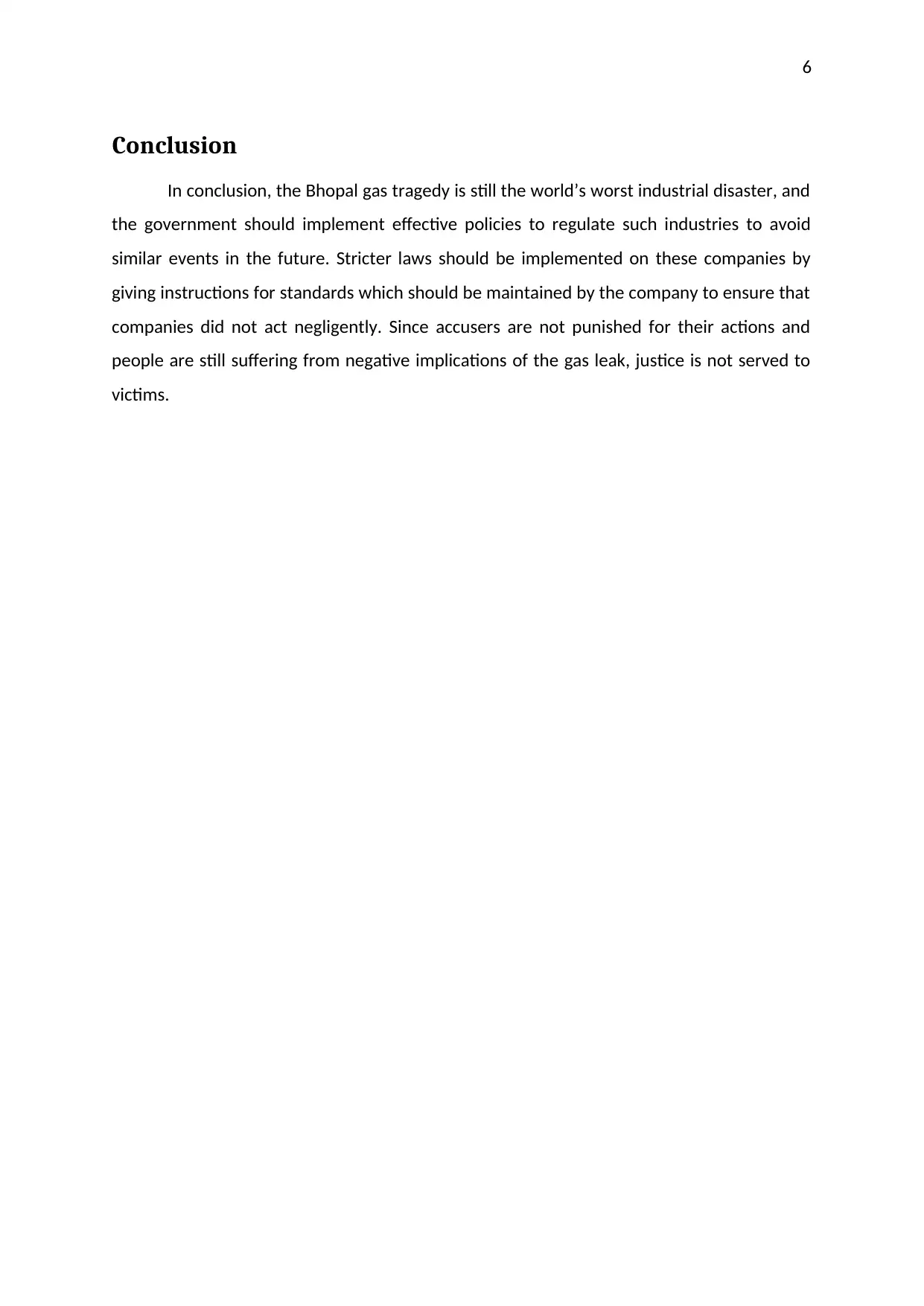
6
Conclusion
In conclusion, the Bhopal gas tragedy is still the world’s worst industrial disaster, and
the government should implement effective policies to regulate such industries to avoid
similar events in the future. Stricter laws should be implemented on these companies by
giving instructions for standards which should be maintained by the company to ensure that
companies did not act negligently. Since accusers are not punished for their actions and
people are still suffering from negative implications of the gas leak, justice is not served to
victims.
Conclusion
In conclusion, the Bhopal gas tragedy is still the world’s worst industrial disaster, and
the government should implement effective policies to regulate such industries to avoid
similar events in the future. Stricter laws should be implemented on these companies by
giving instructions for standards which should be maintained by the company to ensure that
companies did not act negligently. Since accusers are not punished for their actions and
people are still suffering from negative implications of the gas leak, justice is not served to
victims.
Paraphrase This Document
Need a fresh take? Get an instant paraphrase of this document with our AI Paraphraser

7
References
Edwards, T. (2014). Criminal Failure and" The Chilling Effect": A Short History of the Bhopal
Criminal Prosecutions. Social Justice, 41(136), 53-79.
India TV News. (2018). 34 years of Bhopal gas tragedy: All you need to know about 'world's
worst industrial disaster'. Retrieved from https://www.indiatvnews.com/news/india-
34-years-of-bhopal-gas-tragedy-all-you-need-to-know-about-world-s-worst-
industrial-disaster-488787
Mittal, A. (2016). Retrospection of Bhopal gas tragedy. Toxicological & Environmental
Chemistry, 98(9), 1079-1083.
Mukherjee, S. (2016). Surviving Bhopal: Dancing bodies, written texts, and oral testimonials
of women in the wake of an industrial disaster. Springer.
Odysseos, L. (2015). The question concerning human rights and human rightlessness:
disposability and struggle in the Bhopal gas disaster. Third World Quarterly, 36(6),
1041-1059.
Palazzi, E., Curro, F., & Fabiano, B. (2015). A critical approach to safety equipment and
emergency time evaluation based on actual information from the Bhopal gas
tragedy. Process safety and environmental protection, 97, 37-48.
Sharma, S. (2014). Indian media and the struggle for justice in Bhopal. Social Justice, 41
(135), 146-168.
Sinha, I. (2009). Bhopal: 25 years of poison. Retrieved from
https://www.theguardian.com/environment/2009/dec/04/bhopal-25-years-indra-
sinha
Sutaria, A. (2014). Placing the Indian civil nuclear liability regime in context: the extent of
supplier’s liability. Journal of Risk Research, 17(1), 97-113.
Upendra, B. A. X. I. (2016). Human Rights Responsibility of Multinational Corporations,
Political Ecology of Injustice: Learning from Bhopal Thirty Plus?. Business and Human
Rights Journal, 1(1), 21-40.
References
Edwards, T. (2014). Criminal Failure and" The Chilling Effect": A Short History of the Bhopal
Criminal Prosecutions. Social Justice, 41(136), 53-79.
India TV News. (2018). 34 years of Bhopal gas tragedy: All you need to know about 'world's
worst industrial disaster'. Retrieved from https://www.indiatvnews.com/news/india-
34-years-of-bhopal-gas-tragedy-all-you-need-to-know-about-world-s-worst-
industrial-disaster-488787
Mittal, A. (2016). Retrospection of Bhopal gas tragedy. Toxicological & Environmental
Chemistry, 98(9), 1079-1083.
Mukherjee, S. (2016). Surviving Bhopal: Dancing bodies, written texts, and oral testimonials
of women in the wake of an industrial disaster. Springer.
Odysseos, L. (2015). The question concerning human rights and human rightlessness:
disposability and struggle in the Bhopal gas disaster. Third World Quarterly, 36(6),
1041-1059.
Palazzi, E., Curro, F., & Fabiano, B. (2015). A critical approach to safety equipment and
emergency time evaluation based on actual information from the Bhopal gas
tragedy. Process safety and environmental protection, 97, 37-48.
Sharma, S. (2014). Indian media and the struggle for justice in Bhopal. Social Justice, 41
(135), 146-168.
Sinha, I. (2009). Bhopal: 25 years of poison. Retrieved from
https://www.theguardian.com/environment/2009/dec/04/bhopal-25-years-indra-
sinha
Sutaria, A. (2014). Placing the Indian civil nuclear liability regime in context: the extent of
supplier’s liability. Journal of Risk Research, 17(1), 97-113.
Upendra, B. A. X. I. (2016). Human Rights Responsibility of Multinational Corporations,
Political Ecology of Injustice: Learning from Bhopal Thirty Plus?. Business and Human
Rights Journal, 1(1), 21-40.
1 out of 8
Related Documents
Your All-in-One AI-Powered Toolkit for Academic Success.
+13062052269
info@desklib.com
Available 24*7 on WhatsApp / Email
![[object Object]](/_next/static/media/star-bottom.7253800d.svg)
Unlock your academic potential
Copyright © 2020–2025 A2Z Services. All Rights Reserved. Developed and managed by ZUCOL.





